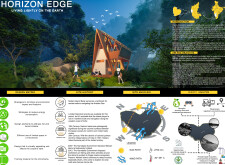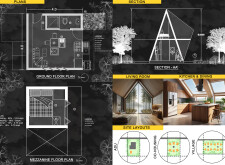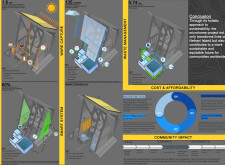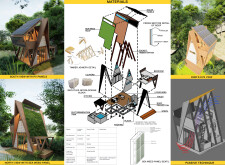5 key facts about this project
### Overview
Located on Netra Island in the Arabian Sea, the Horizon Edge project addresses sustainability and social equity in housing amidst growing urbanization and climate change challenges. This micro-home initiative integrates eco-friendly practices with modern living, aiming to serve as a model for future developments in ecologically sensitive areas, particularly in the context of Netra Island’s designation as a biodiversity hotspot in 2007.
### Environmental Response
The architectural design is informed by the island's tropical climate, marked by temperatures averaging 28°C to 30°C. The project optimally utilizes natural ventilation and sunlight through strategically placed openings. Analyzing sun and wind patterns has guided the building's orientation, enhancing both comfort and energy efficiency. The A-frame structure aids in efficient water runoff and provides structural resilience against wind forces while maximizing views and daylighting potential.
### Material Selection
Material choices reflect a strong commitment to sustainability. Key components include seaweed roof panels for insulation, locally sourced coconut timber for structural elements, and recycled interlocking blocks that repurpose waste into valuable resources. Photovoltaic solar panels provide renewable energy, bolstering the project’s energy independence, while hydrogel insulation panels effectively regulate internal temperatures. These selections not only emphasize environmental responsibility but also minimize maintenance requirements, ensuring long-term functionality.
### Spatial Configuration
The interior layout emphasizes efficient use of space, featuring designated areas for sleeping, cooking, and communal activities. The ground floor includes living, kitchen, and dining spaces to facilitate social interaction, while the mezzanine accommodates private sleeping areas, maintaining an open flow. Multifunctional elements, such as foldable furniture and convertible areas, maximize utility within the compact design, exemplifying effective spatial management that enhances user comfort.
### Sustainability Practices
The project incorporates advanced strategies for waste and water management, including rainwater harvesting systems and facilities for waste separation, aimed at reducing resource consumption. Smart technology is integrated to monitor and optimize energy use, further minimizing environmental impact. Additionally, the inclusion of micro-farming capabilities encourages residents to produce their own food, promoting self-sufficiency and supporting local ecosystems.
Through these elements, the Horizon Edge project exemplifies a comprehensive approach to modern housing that prioritizes ecological integrity and community engagement while remaining financially viable.






















































